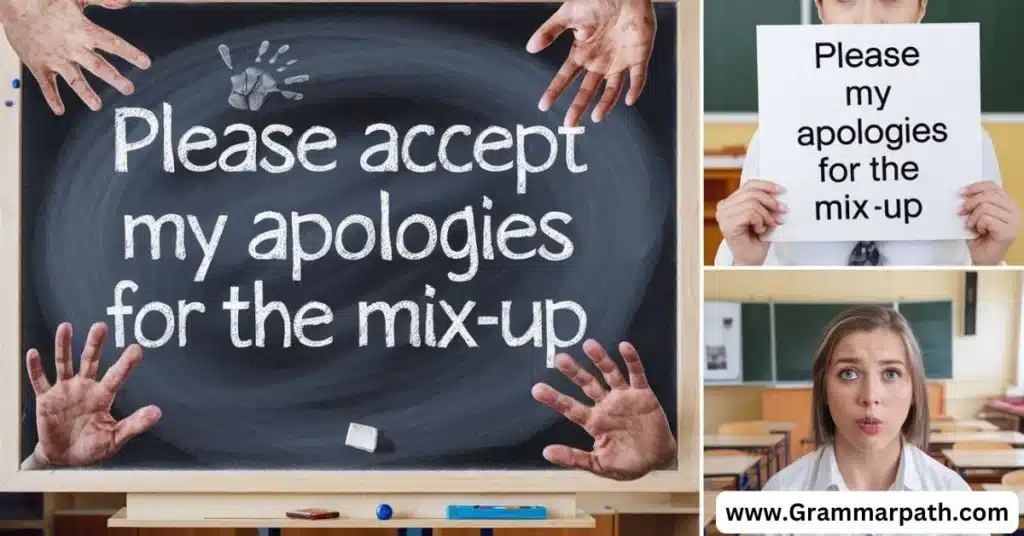
20 Other Ways to Say “Sorry for the Confusion” (With Examples)
Sorry for the confusion is a popular phrase often used when someone wants to express regret for a misunderstanding or mix-up. But sometimes, using the same phrase repeatedly can feel impersonal or lack the tone you’re aiming for, whether in formal or informal communication.
If you’re looking for alternatives to saying sorry for the confusion, this article will offer you 20 unique ways to express your apology effectively. From casual to professional settings, these phrases can help you communicate effectively and ensure clarity in your messaging.
Is It Professional to Say “Sorry for the Confusion”?
Yes, it can be professional, but it depends on the context and how often you use it. For more formal scenarios, alternatives like “I apologize for the confusion caused” or “my apologies for the miscommunication” might be better choices. A professional tone is key when addressing misunderstandings in business communication.
Key Takeaways
- There are various ways to apologize without using the overused phrase “sorry for the confusion.”
- Choosing the right phrase depends on the tone of communication, whether it’s formal or casual.
- Crafting the perfect apology requires clear communication and responsibility for any misunderstanding caused.
How Do These Phrases Differ?
Each of the alternatives listed below carries a unique tone or message. For instance, while “I apologize for the confusion” is professional and straightforward, a phrase like “Oops…my bad for the mix-up” might be suitable in a more relaxed or informal setting. Knowing the differences in communication style can help you choose the most appropriate apology based on the context.
What to Say Instead of “Sorry for the Confusion”
- I apologize for the confusion
- Apologies for the misunderstanding
- Sorry for the misunderstanding
- My apologies for any ambiguity
- Apologies for the miscommunication
- Apologies for the mix-up
- I apologize for any confusion caused
- Sorry for any unclear messaging
- Sorry if I caused confusion
- Sorry for the confusion caused
- I Regret Any Misunderstanding
- Apologies for the Oversight
- Sorry for the Miscommunication
- I’m Sorry for Any Inconvenience Caused
- Please Accept My Apologies for the Mix-Up
- I’m Sorry for the Misunderstanding
- My Apologies for Any Confusion This May Have Caused
- Sorry for Any Mix-Up
- I Take Full Responsibility for the Confusion
- Sorry for Any Miscommunication on My End
1. I Apologize for the Confusion

This is a professional and respectful alternative to the original phrase. It’s perfect for business emails and formal situations.
Example:
Email to a client:
“Dear Sarah, I apologize for the confusion regarding the schedule. Please find the updated meeting time below. Let me know if this works for you.”
2. Apologies for the Misunderstanding
This phrase is softer but still conveys a sense of apology. It’s suitable for both formal and informal settings.
Example:
In a text to a friend:
“Apologies for the misunderstanding about the dinner plans. I meant Friday, not Saturday. Hope you can still make it!”
3. Sorry for Any Unclear Messaging
A phrase that acknowledges ambiguity in previous communication, great for formal use where clarity is key.
Example:
Project email:
“Hi team, sorry for any unclear messaging in my last update. Here’s a detailed breakdown to clear things up.”
4. My Apologies for Any Ambiguity
This phrase explicitly attributes the misunderstanding to unclear communication and is ideal for professional correspondence.
Example:
Email to a supervisor:
“My apologies for any ambiguity in my earlier email. To clarify, I was referring to the quarterly report, not the annual summary.”
5. Apologies for the Miscommunication
A concise yet formal way to admit a miscommunication issue, perfect for business settings.
Example:
Customer service email:
“Apologies for the miscommunication on our part. We will ensure that your order is processed correctly.”
6. Sorry for Any Unclear Messaging

This phrase highlights any vagueness in your prior communication.
Example:
Message to a colleague:
“Sorry for any unclear messaging in my last email. The deadline is Friday, not Monday.”
7. Apologies for the Mix-Up
This casual phrase is perfect for situations where the confusion is minor, and you’re addressing it casually.
Example:
Message to a team member:
“Apologies for the mix-up with the report. It’s on my desk now!”
8. I Apologize for Any Confusion Caused
This phrase is direct and professional, perfect for formal communication.
Example:
Email to a client:
“I apologize for any confusion caused by my previous email. Please see the correct details attached.”
9. Sorry If I Caused Confusion
This is an acknowledgment of responsibility, but still offers a polite apology.
Example:
Email to a partner:
“Sorry if I caused confusion during the meeting earlier. Here’s a clearer explanation of what I meant.”
10. My Bad for the Mix-Up

This is an informal alternative, ideal for casual conversations.
Example:
Message to a friend:
“Oops, my bad for the mix-up on the directions. It’s the second building, not the first.”
11. I Regret Any Misunderstanding
This phrase is a formal and polite way to take responsibility for a misunderstanding without sounding too casual. It works well in professional emails.
Example:
Email to a client:
“I regret any misunderstanding that may have occurred in our previous conversation. Please allow me to clarify the next steps for you.”
12. Apologies for the Oversight
This phrase is ideal when the confusion was caused by an overlooked detail. It’s commonly used in business communications to apologize for missing something important.
Example:
Email to a colleague:
“Apologies for the oversight regarding the project deadline. I’ll ensure all the necessary files are submitted by tomorrow.”
13. Sorry for the Miscommunication
A straightforward alternative that works well in both formal and informal settings when the issue was due to miscommunication.
Example:
Text to a friend:
“Sorry for the miscommunication about the meeting spot. I’ll be at the coffee shop on Main Street, not the one downtown.”
14. I’m Sorry for Any Inconvenience Caused
This phrase is especially useful when the confusion led to someone being inconvenienced. It shows consideration for the other person and works well in customer service scenarios.
Example:
Customer service email:
“I’m sorry for any inconvenience caused by the delay in processing your order. We are working to resolve the issue as soon as possible.”
15. Please Accept My Apologies for the Mix-Up

This is a polite and formal alternative often used in written communications to express regret for confusion.
Example:
Email to a client:
“Please accept my apologies for the mix-up regarding the appointment time. We have rescheduled it to 2 PM as per your request.”
16. I’m Sorry for the Misunderstanding
This phrase is perfect when acknowledging a misunderstanding that may have occurred between two people. It works well in both formal and informal contexts.
Example:
Message to a colleague:
“I’m sorry for the misunderstanding during today’s meeting. Let me explain the point I was trying to make more clearly.”
17. My Apologies for Any Confusion This May Have Caused
A formal phrase that works well in professional emails and business settings. It shows responsibility while keeping the tone polite.
Example:
Email to a client:
“My apologies for any confusion this may have caused. Here is the correct information you requested.”
18. Sorry for Any Mix-Up
A more casual alternative, this phrase works well in informal settings where the confusion was minor but still needs acknowledgment.
Example:
Message to a friend:
“Sorry for any mix-up on the time for dinner tonight. I meant to say 7 PM!”
19. I Take Full Responsibility for the Confusion
This is a professional phrase often used to take full accountability for any confusion caused in business communication.
Example:
Email to a team member:
“I take full responsibility for the confusion about the project timeline. Please refer to the updated schedule I’ve attached.”
20. Sorry for Any Miscommunication on My End

This phrase works well when the source of confusion was your own unclear communication. It’s suitable for both formal and informal settings.
Example:
Message to a friend:
“Sorry for any miscommunication on my end. I’ll make sure to double-check the details next time.”
How to Use These Phrases Formally
When apologizing in a business communication context, it’s important to maintain a professional tone and explicitly attribute any confusion to a specific point or message. Formal phrases such as “I apologize for the misunderstanding” and “My apologies for any confusion caused” are ideal for maintaining polished communication.
Example:
“Dear Mr. Thompson, I apologize for the confusion regarding the meeting time. Please allow me to clarify: the meeting is scheduled for 3 PM tomorrow.”
How to Use These Phrases Informally
In informal settings, you can adopt a more relaxed tone, such as using “Oops, my bad for the mix-up” or “Sorry if I caused confusion.”
Example:
Text message to a friend:
“Oops, my bad for the mix-up earlier! I meant to say 6 PM, not 7 PM. See you then!”
Pro Tips for Crafting the Perfect Apology
- Acknowledge the Issue: Start by acknowledging the problem directly and clearly. This shows you take responsibility and are aware of the issue.
- Offer Clarification: After the apology, provide a clear explanation of what went wrong and how you intend to fix it. This can help prevent future confusion.
- Tailor Your Tone: Depending on the context, your apology should match the tone of your communication, whether formal or casual.
Frequently Asked Question
How do you say “sorry for confusion”?
You can say, “I apologize for the confusion” or “My apologies for any misunderstanding.” These are polite and professional alternatives.
How do you apologize for being confused in an email?
In an email, you can say, “I apologize for my confusion” or “I’m sorry for any misunderstanding on my part.” Both phrases acknowledge your confusion politely and professionally.
How do I say I’m sorry for the misunderstanding?
You can say, “I apologize for the misunderstanding” or “My apologies for the miscommunication.” Both are polite and professional ways to express regret for the misunderstanding.
What are 5 ways to say sorry?
Here are five ways to say sorry:
- “I apologize for that.”
- “I’m sorry, I didn’t mean to.”
- “My apologies for the mistake.”
- “Please forgive me.”
- “I regret the error.”
Final Thoughts
In conclusion, saying “Sorry for the confusion” is a powerful way to acknowledge misunderstandings and promote clear communication. By taking responsibility for any mix-ups, you demonstrate professionalism and respect for others. Utilizing various phrases to express your regret can enhance your relationships, whether in personal or professional settings.
Remember that effective communication is key to avoiding future misunderstandings. By being sincere and proactive, you can foster an environment of transparency and trust, ultimately leading to more productive interactions and better outcomes.

Emily Olivia is an experienced writer specializing in grammar and English language topics. With a passion for clarity and precision, she shares valuable insights on synonyms, grammar rules, and writing tips to help readers enhance their language skills on Grammar Path.





